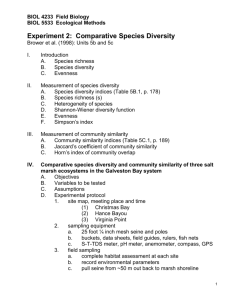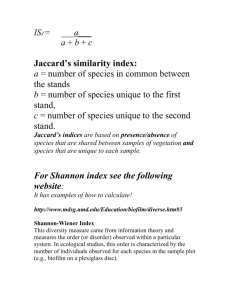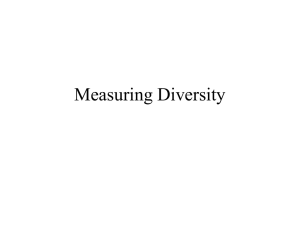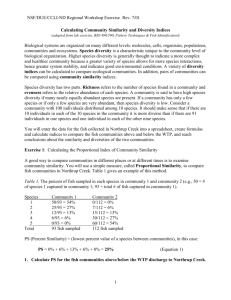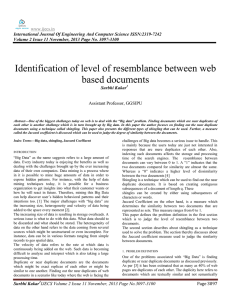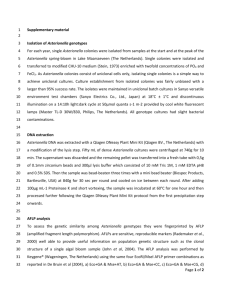Introduction to the analysis of community data
advertisement
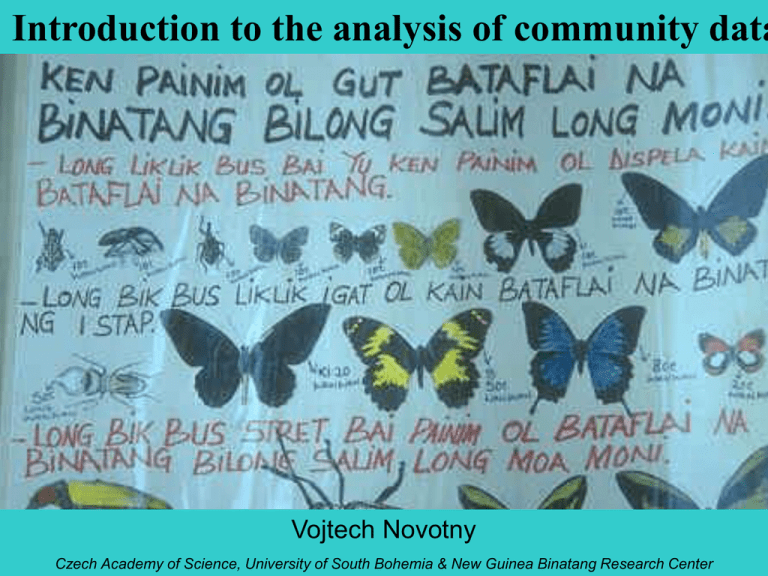
Introduction to the analysis of community data Vojtech Novotny Czech Academy of Science, University of South Bohemia & New Guinea Binatang Research Center Ecological analysis of community samples typical data format: Some of the questions you can ask about the samples: How many species? How many individuals? What species are common / rare? How different are the sites in their species composition? How different are the species in their distribution? Presence – absence characteristics: number of species and sites Species accumulation curve 21 19 No. of species . 17 15 13 11 9 Site accummulation 1-2-3-4-5 Randomised sites 7 5 1 2 3 No. of sites 4 5 How many species? Corrected estimate for missing species Chao1 S + singletons2/(2*doubletons) S – number of species sampled Courtesy Jonathan Coddington . Courtesy Jonathan Coddington No. of species often depends on the number of individuals: samples with more individuals have also more species No. of species 25 20 Rarefraction: 15 Comparing the number of species in a random selection of the same number of individuals from each sample 10 5 observed rarefraction 36 ind. 0 0 100 200 300 400 No. of individuals 500 600 Diversity measures: describing distribution of individuals among species Simpson’s index: the probability that two individuals chosen from your sample will belong to the same species Berger-Parker’s index: share of the most common species 0.6 Site 1 Berger-Parker index 0.5 0.4 0.3 0.2 0.1 0 0.00 Site 5 0.05 0.10 0.15 0.20 Simpson's index 0.25 0.30 0.35 Diversity estimate: Simpson’s diversity: 1- ∑[ni(ni-1)/N(N-1)] ni – number of individuals from species i, N – total number of individ. Berger-Parker’s Index: nmax/N nmax = abundance of the most common species, N – total no. of individ. Alpha, beta and gamma diversity alpha diversity beta diversity = avg + gamma diversity avg = 16.6 = 20 α = 20 - 16.6 = 3.4 β γ Community similarity estimate: Jaccard similarity: shared species/[total species X + Y] Jaccard similarity = A/(A+B+C) X, Y - samples X Y Similarity indices Koleff et al. 2003 J anim Ecol 72:367 EstimateS data format, saved as TXT file Chao1 S + singletons2/(2*doubletons) S = number of species sampled Jaccard CJ CJ = a / (a + b + c) a = richness in first site, b = richness in second site, j = shared species Sorenson CS CS = 2a / (2a + b +c) Simpson's Index (D) measures the probability that two individuals randomly selected from a sample will belong to the same species Jaccard Coefficient • number of shared species as proportion of total number of species in the two SUs • ranges from 0 (no species in common) to 1 (the SUs have identical species lists) a J S abc SU 1 SU 2 Present Absent Present a b Absent c d Sørenson Coefficient • like Jaccard, ignores shared absences S BC 2a 2a b c SU 1 SU 2 Present Absent Present a b Absent c d Quantitative Version of Sørenson (Bray-Curtis) Similarity S BC jk 2W jk T j Ts k 2 min X ij , X ik i 1 s s X X i 1 ij i 1 ik • Morisita-Horn CmH – Not influenced by sample size & richness – Highly sensitive to the abundance of common spp. – CmH = 2S(ani * bni) / (da + db)(aN)(bN) • aN = total # of indiv in site A • ani = # of individuals in ith species in site A • da = Sani2 / aN2

